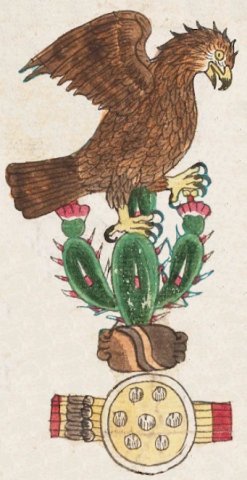Tenochtitlan (Mdz2r)
This compound glyph for the place name Tenochtitlan features an eagle (in profile, facing to the viewer's right) with its beak open and its raised wings, perched on a nopalli cactus which bears a fruit called nochtli. Below the cactus is a stone (tetl), which provides the phonetic for the start of the place name. Below the stone is a round yellow shield with seven white down feather balls (probably tlachcayotl) formed into the ihuiteteyo shield design) and with horizontal red and yellow arrows behind the shield. The shield and arrows are symbols for war. The claw on the eagle's left foot is grasping at one of the blossoms or fruits on the cactus, perhaps to draw attention to the nochtli. The thorns on the cactus are red and white, with the red possibly pointing to blood. The coloring is similar to the flint knives used for making sacrificial offerings and similar to the thorns on the huixachin. The ligature (-ti-) locative suffix (-tlan) are not shown visually.
Stephanie Wood
Tenochtitlan was the imperial capital of the so-called Aztec empire, and it was the site of the seizure of power by the Spanish invaders, 1519–1521. The down balls on the shield sometimes number seven and sometimes eight, as Ian Mursell has noted. While the eagle, the shield, and the arrows are not always part of the compound hieroglyph for Tenochtitlan, we are including them here because, as Mursell also notes, this fuller complex was akin to a "coat of arms" for the city.
While the word for eagle (cuauhtli) does not feature in this place name, it is part of the central design of the modern Mexican flag, and does appear on some other compound glyphs, as seen in one published in Wikipedia where water (probably referring to the lakes around the city) and a snake in the eagle's beak also appear. Its pose with raised wings is also typical in the Codex Mendoza, as shown below. However, sometimes the hieroglyph for eagle, as with many animals, is abbreviated to the head only. One wonders whether the open beak suggests an eagle cry, as the audio could be powerful.
For a comparable glyph of Tenochtitlan, please see Marc Thouvenot's vignette based on an image from the Códice Durán, https://vignettes.sup-infor.com/imagen/2-DU_01_014v_a.
Stephanie Wood
tenochtitlan
Tenochtitlan
Stephanie Wood
c. 1541, or by 1553 at the latest
Xitlali Torres and Stephanie Wood
There are really more elements than two, but only two provide the phonetic elements for Tenoch-, and the -titlan (ligature and locatives suffix) is not included in the visuals.
Several elements in this complex are not part of the place name. The reading order for "upward" refers to the stone (te-) and the cactus fruit (-noch-).
shields, escudos, rodelas, feathers, plumas, eagles, águilas, nopales, cactos, capitales, ciudades, altepetl, nombres de lugares

Tenochtitlan, "On the Cactus of the Stone," https://nahuatl.wired-humanities.org/content/tenochtitlan
"By the Rock Cactus" [Gordon Whittaker, Deciphering Aztec Hieroglyphs, 2021, 111]. "Place of the Cactus Fruit on the Stone" [Jongsoo Lee, The Allure of Nezahualcoyotl, 2008, 258.]
En el Tunal de la Piedra
Frances Karttunen (see the Online Nahuatl Dictionary).
Codex Mendoza, folio 02 recto, https://codicemendoza.inah.gob.mx/inicio.php?lang=english.
The Bodleian Libraries, University of Oxford, hold the original manuscript, the MS. Arch. Selden. A. 1. This image is published here under the UK Creative Commons, “Attribution-NonCommercial-ShareAlike 3.0 License” (CC-BY-NC-SA 3.0).




